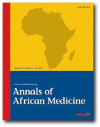
|
Annals of African Medicine
Annals of African Medicine Society
ISSN: 1596-3519
Vol. 5, No. 3, 2006, pp. 118-121
|
 Bioline Code: am06028
Bioline Code: am06028
Full paper language: English
Document type: Research Article
Document available free of charge
|
|
|
Annals of African Medicine, Vol. 5, No. 3, 2006, pp. 118-121
| fr |
Abdul, M. A.; Mohammed, A.; Mayun, A. & Shittu, S. O.
Résumé
Introduction :
La fréquence des cas d'adénocarcinome de col est en augmentation dans bien des parties du monde. Il y a une pénurie d'information en ce qui concerne cancer non squameux du col dans notre milieu.
Méthode :
Une analyse descriptive impliquant des cas maligns non squameux histologiquement confirmés de col au cours d'une période de dix ans à partir du janvier 1994 au décembre 2003.
Résultats:
Pendant la période d'étude, il y avait 361 cas des cancers cervicaux histologiquement confirmés dont 322 soit 89,2% étaient cellulite carcinome squameuse et 10,8% étaient cellulite carcinome squameuse et 10,8% étaient cellulite malignité non-squameuse. Tous les 39 cas du cancer de cellule non-squameux à l'exception d'un cas étaient adénocarcinome (97,4%). L'exception était un cas de léiomyosarcome. Adénocarcinome pur est une forme la plus ordinaire d'adénome carcinome 60,5% suivi par adénosquame variant (21,1%). L'âge moyen de 39 patients était 42,9+-7,2 ans (tranche 2 – 12). Tous les patients étaient symptomatiques avec l'utérin saignant anormal associé au écoulement/pertes vaginales vues chez 89,5 des cas. 80% des patients ont été diagnostiqués étape en avance.
Conclusion:
Cancer de col non-squameux constitue 11% de tous les cas des maligns cervicaux à Zaria et adénocarcinome est la forme la plus ordinaire. Le profil clinique d'adénocarcinome du col ne semble pas être différant de celui du cancer de la cellule squameuse. Des études supplémentaires sont exigées afin de comparer le prognose entre les deux types des cellules histologiques dans notre milieu.
Mots Clés
Col, carcinome, non-squameux
|
| |
| en |
Non-Squamous Cell Carcinoma of the Cervix in Zaria, Northern Nigeria: A Clinico-Pathological Analysis
Abdul, M. A.; Mohammed, A.; Mayun, A. & Shittu, S. O.
Abstract
Background:
The incidence of Adenocarcinoma of the cervix is on the increase in many parts of the world. There is paucity of information regarding non-squamous cancer of the cervix in our setting.
Method:
Descriptive analysis involving consecutive histological confirmed cases of non-squamous malignancy of the cervix over a ten-year period from January 1994 to December 2003.
Results:
During the period of study, there were 361 histological confirmed cases of cervical cancer of which 322 (89.2%) were squamous cell carcinoma and 10.8% were non-squamous cell malignancy. All the 39 cases of non-squamous cell cancer except one were adenocarcinoma (97.4%). The exception was a case of leiomyosarcoma. Pure adenocarcinoma is the commonest form of adenocarcinoma (60.5%) followed by adenosquamous variant (21.1%). The mean age of the 39 patients was 42.9±7.2years (range 29 – 75 years) and mean parity of 5.5±2.9 (range 2 – 12). All the patients were symptomatic with abnormal uterine bleeding associated with vaginal discharge seen in 89.5% of cases. 80% of the patients were diagnosed in advanced stage.
Conclusion:
Non-squamous cancer of the cervix constitutes 11% of all cervical malignancy in Zaria and adenocarcinoma is the commonest form. The clinical profile of adenocarcinoma of the cervix does not appear to differ from that of squamous cell cancer. Further studies are needed to compare the prognosis between the two histological cell types in our environment.
Keywords
Cervix, carcinoma, non-squamous
|
| |
© Copyright 2006 - Annals of African Medicine
Alternative site location: http://www.annalsafrmed.org
|
|
